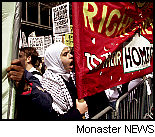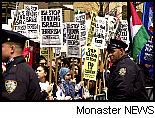Residents of quiet 74th St., a few blocks from the Narrows in Bay Ridge, have been waking to the quaking of their homes lately as heavy machinery rolls in.
Repairs to step street at 74th St. and Colonial Road in Bay Ridge have delighted tenants, though they must endure intrusion of heavy machinery.
It is the start of a major project to replace the unusual step street linking Ridge Blvd. and Colonial Road at 74th St., as well as repair the street’s sewers and water mains.
“Let’s face it, it has to be done,” said Blanca Ortiz of 115 74th St.
But that doesn’t mean she enjoys it. “I’m in bed this morning and the bed, along with the house, was shaking,” Ortiz said.
She quickly called Janet Richichi, community construction liaison from the city Department of Design and Construction.
“I told her that I hope our houses don’t develop cracks because of the pounding,” Ortiz said. “She told me that she’d consulted with the engineers and that they’re not supposed to pound beyond a certain degree so as to not cause any damage.
“It’s an inconvenience, and the noise, but it has to be done.”
The consolation for the neighborhood is that its unusual public steps finally will be repaired.
Assemblywoman Joan Millman (D-Bay Ridge) secured the $300,000 that Community Board 10 officials told her in 1997 it would cost to fix the steps.
“In my enthusiasm and my naiveté about how these things work, I thought it was going to happen, like, right away,” Millman said.
When city officials inspected the project, they found that the sewers and water mains needed total reconstruction along with the stairway. It took the intervening four years to get the $786,000 estimated cost for the project into the budget, with the city Department of Environmental Protection picking up the tab for the remainder of the project.
City Design and Construction Department Deputy Commissioner Matthew Monahan said the street above and below the steps would have 600 new feet of curb, three fire hydrants and five catch basins to draw off rainwater, along with the new steps, sewer and water main, when the project is completed in July.
The repairs were long overdue, said Steve Harrison, chairman of Community Board 10. “The steps are unsafe,” he said.
“That they are fixing them is something that makes us ecstatic.”
Step streets are more common in the Bronx, but Brooklyn, being part of Long Island, is flatter. Harrison believes only two such street steps exist in the borough, the set under reconstruction and another set on 76th St.
Marylou Notaro of 145 74th St., who has lived in the neighborhood for 15 years, praised the city workers doing the job but said she was concerned about what would happen to a community garden on either side of the steps.
“About 10 years ago, we turned an area that was a dumping ground into a beautiful garden, and people from all around the neighborhood came to admire the roses and the tulips and the daffodils,” Notaro said.
“I’m hopeful that after the construction is done, we can restore the garden to the beautiful garden that it once was.”



 Sunday, December 3, 2000
Sunday, December 3, 2000 Sunday, December 19, 1999
Sunday, December 19, 1999